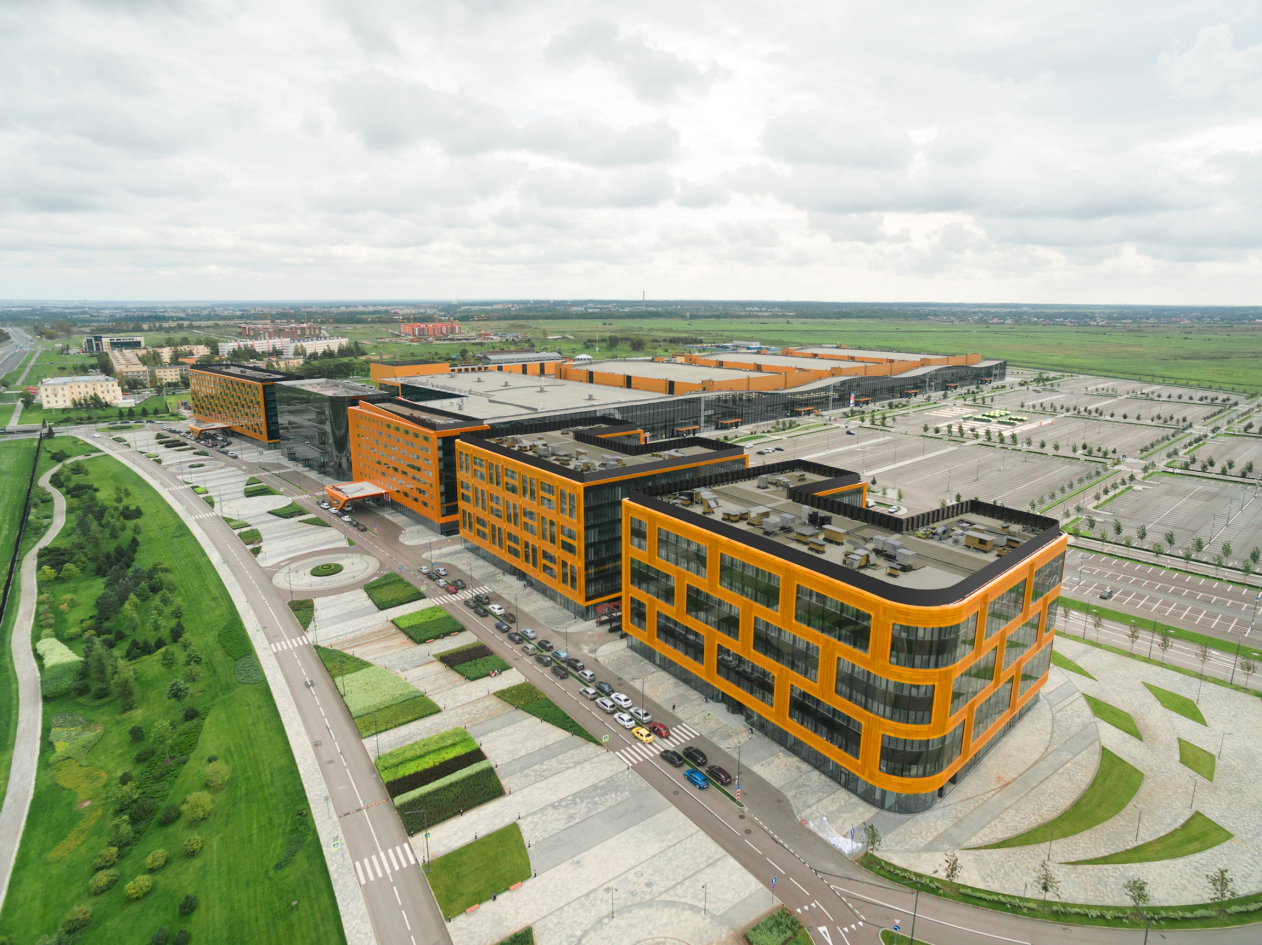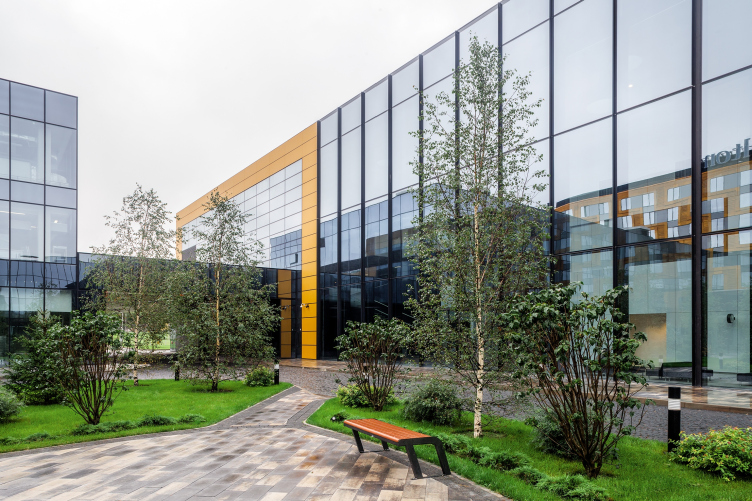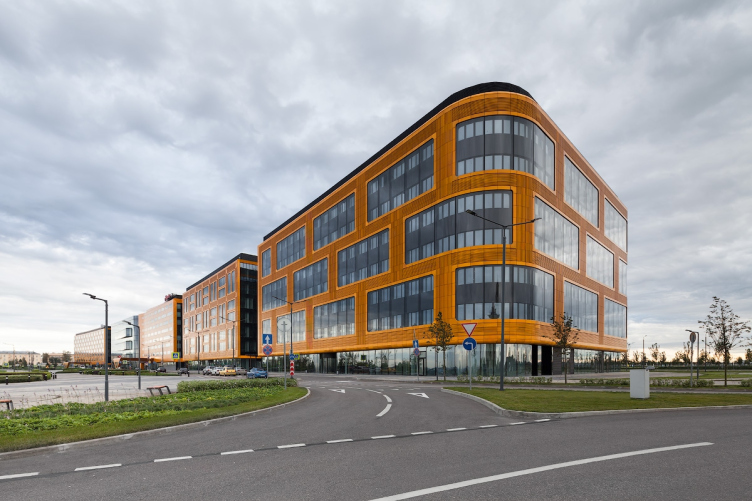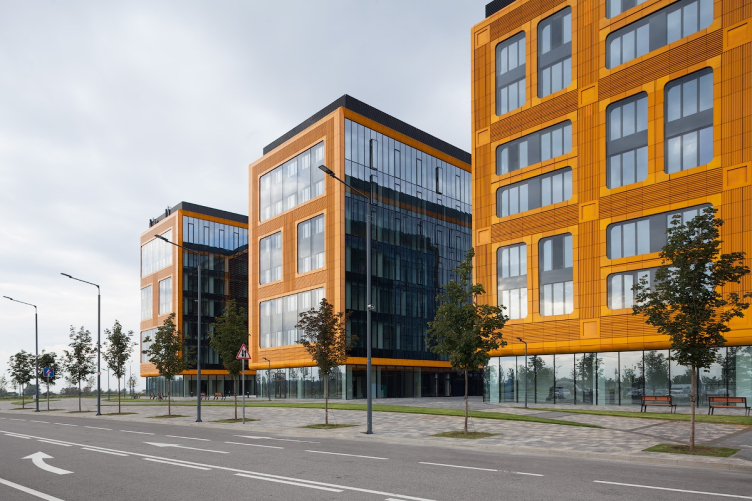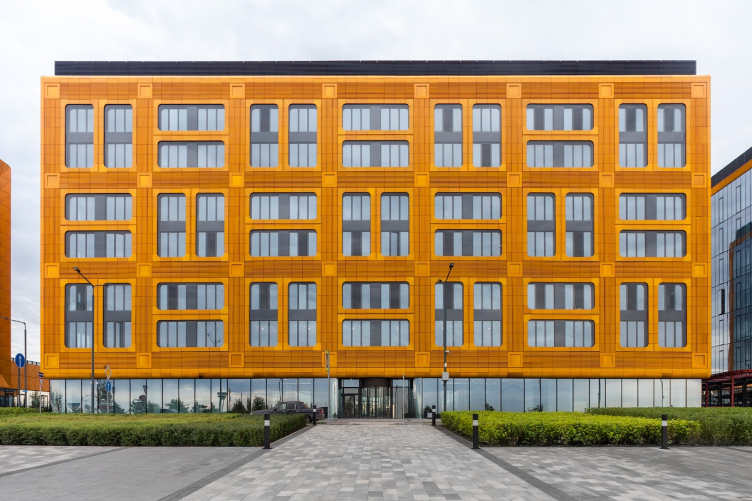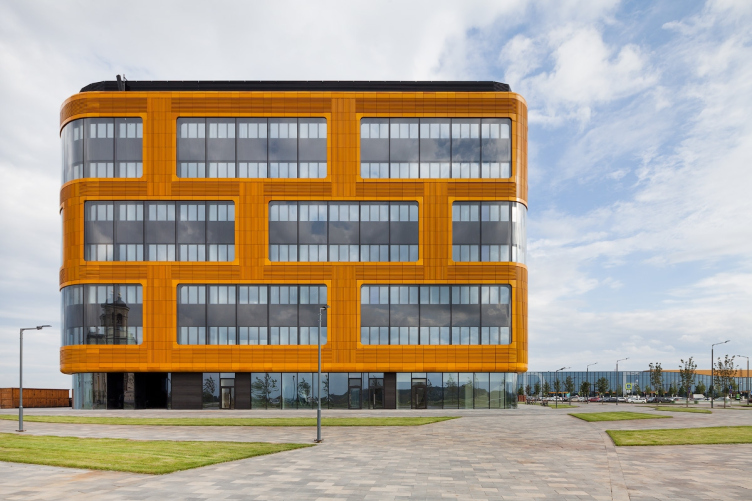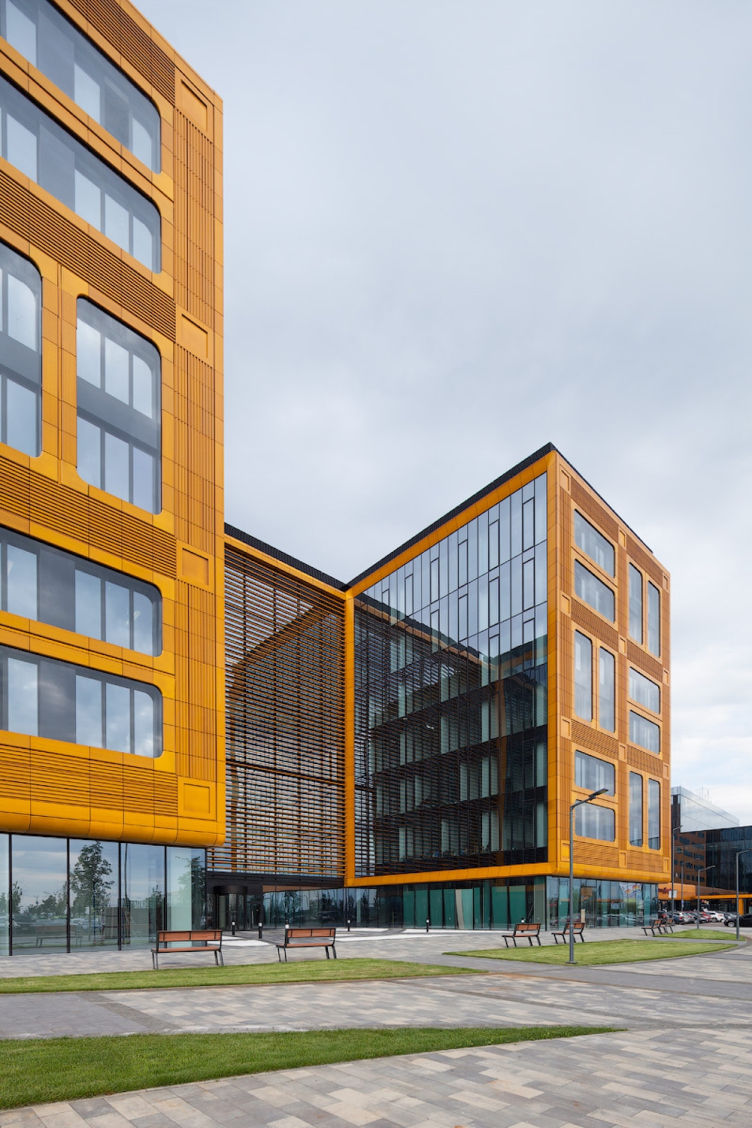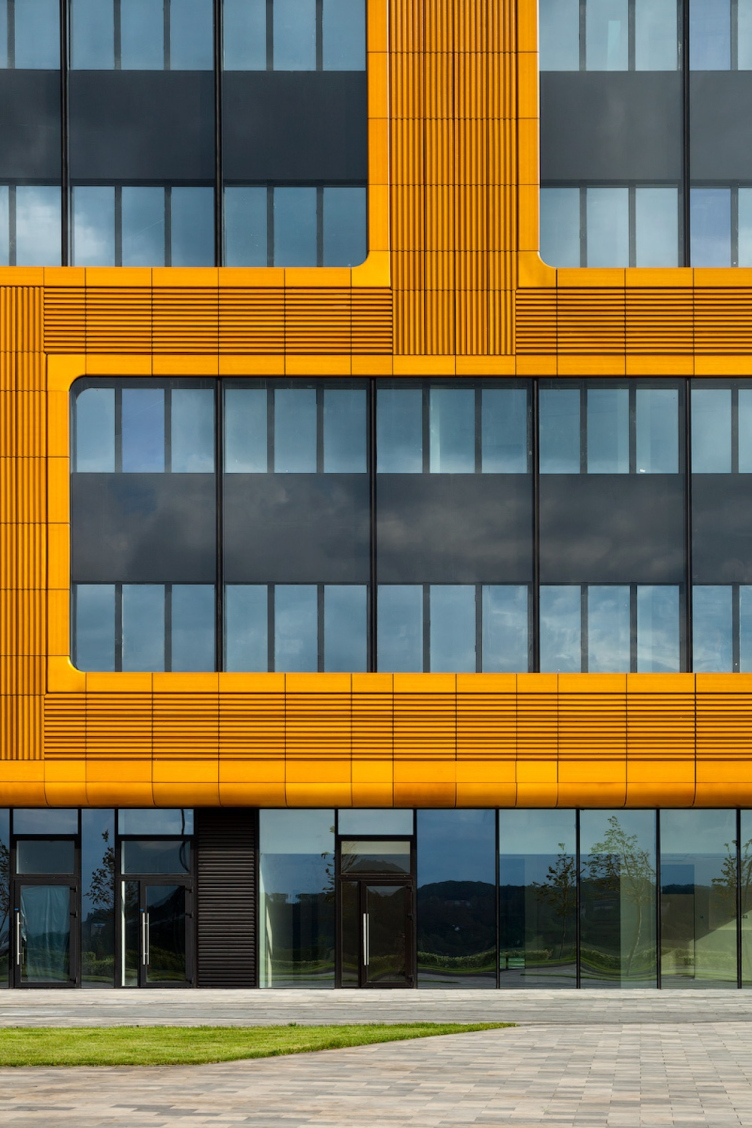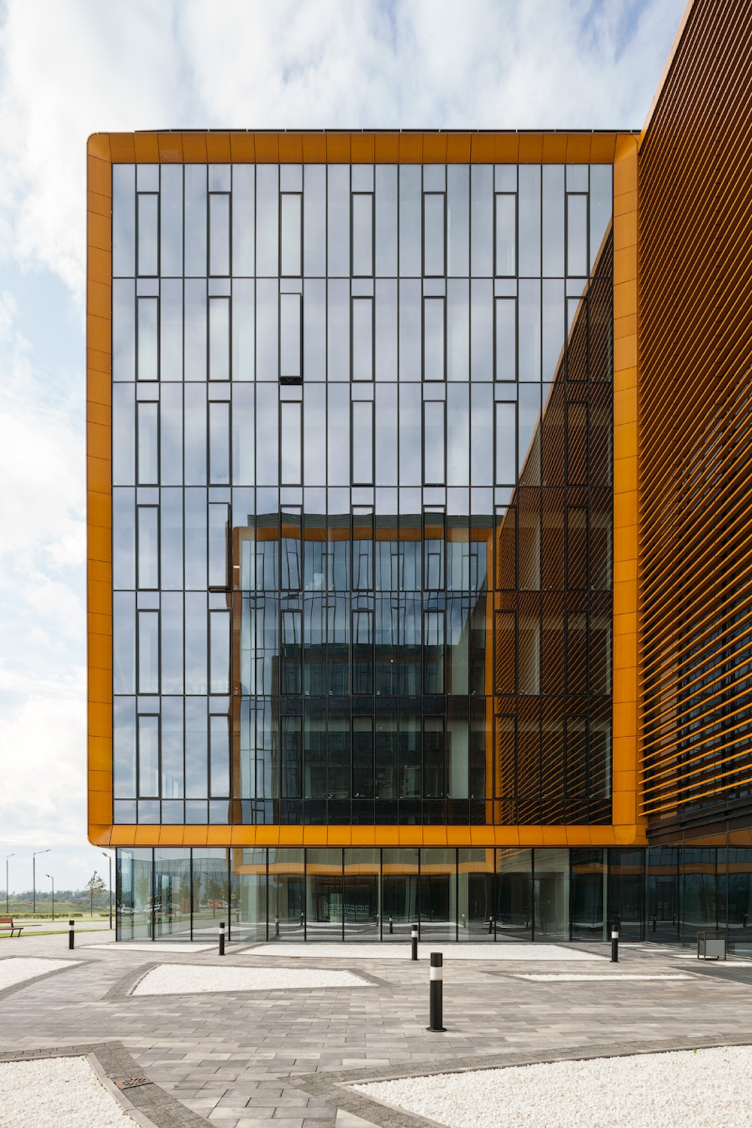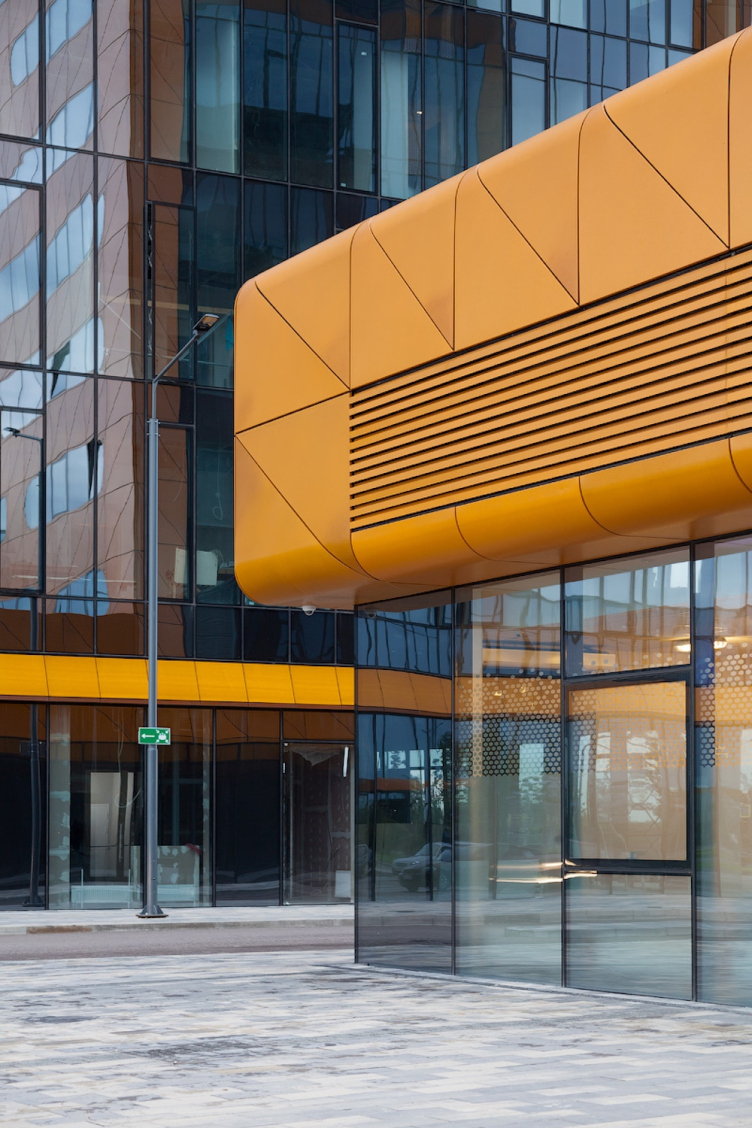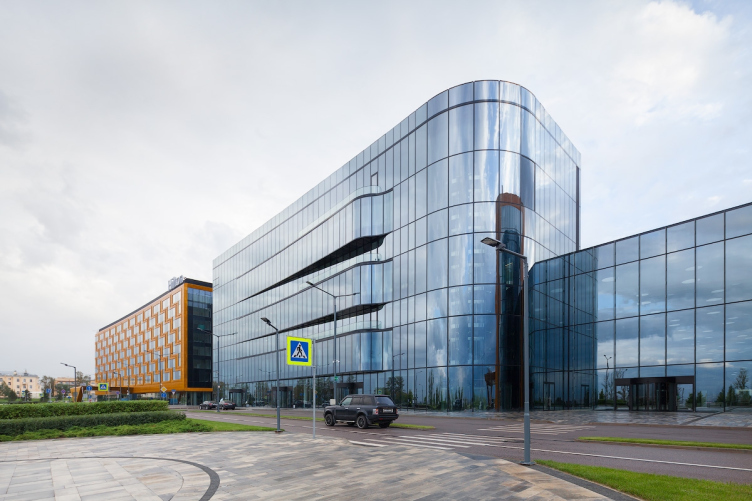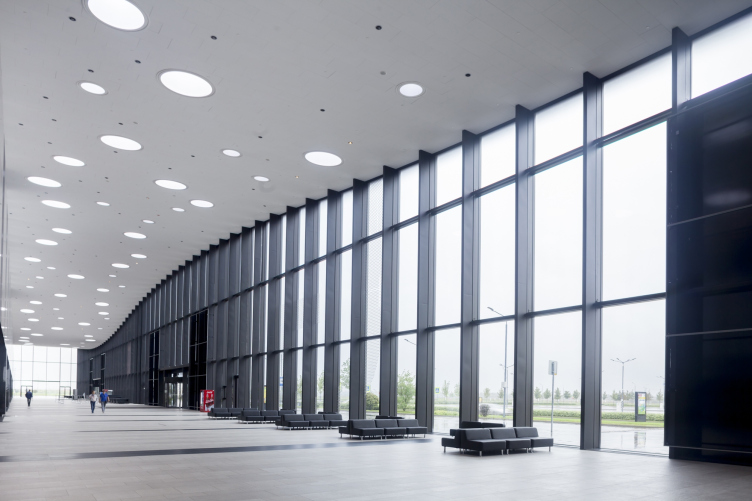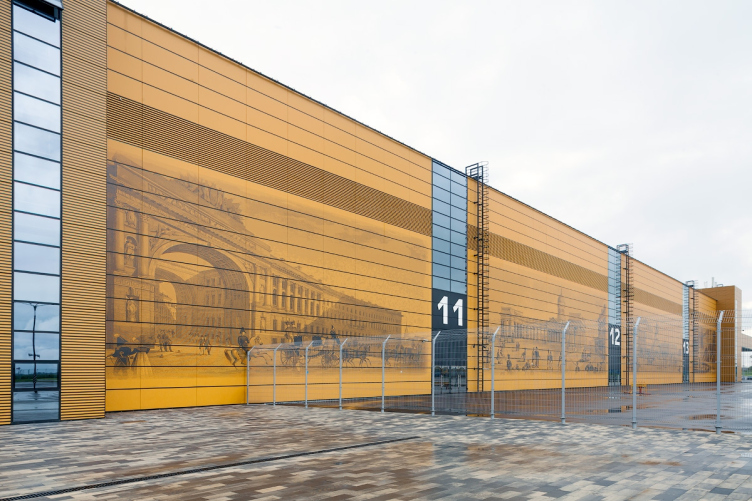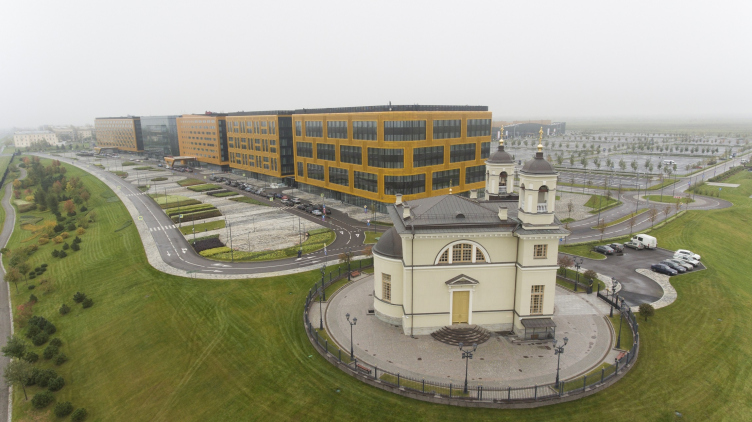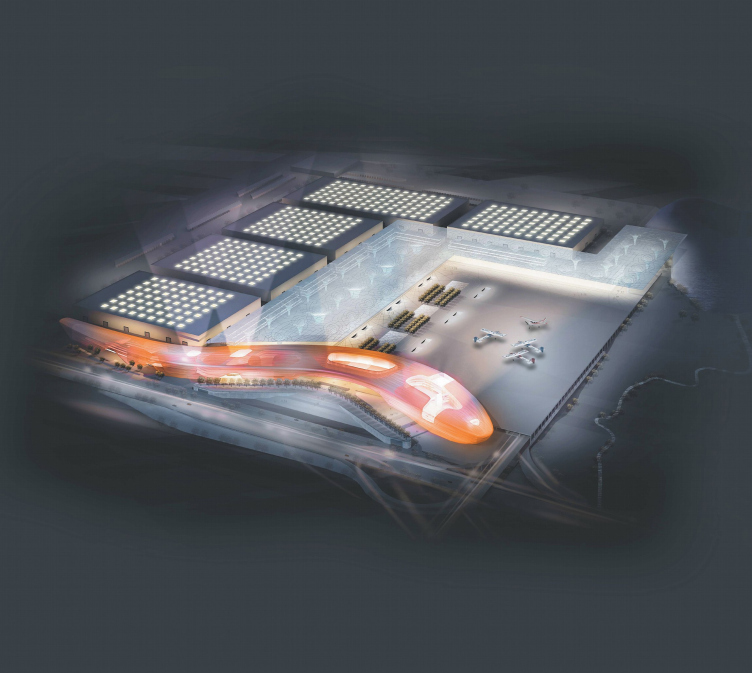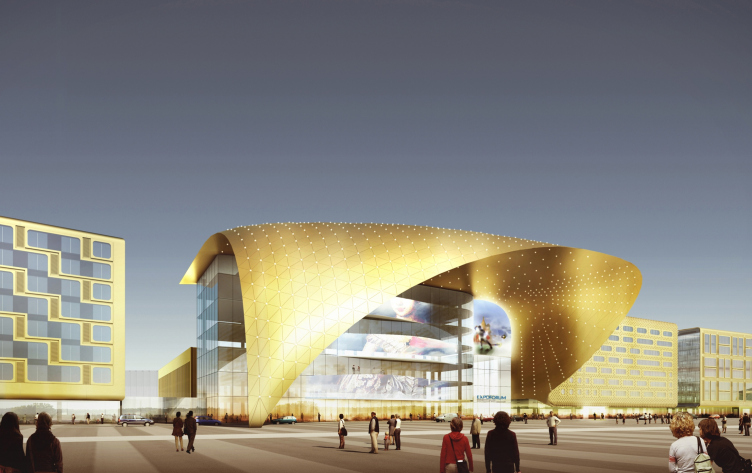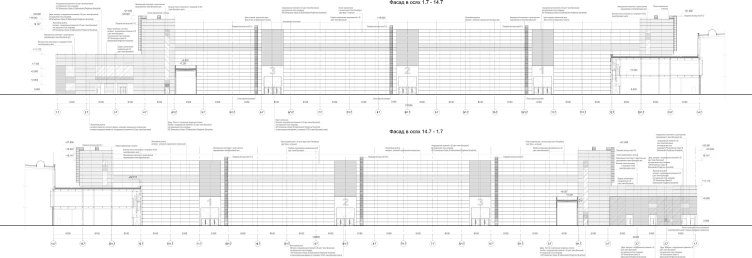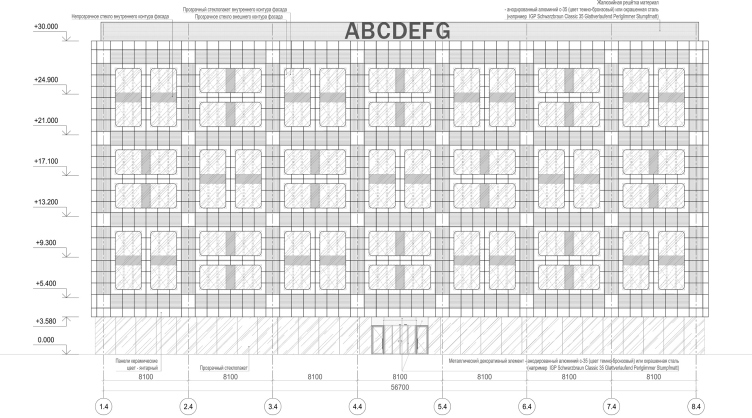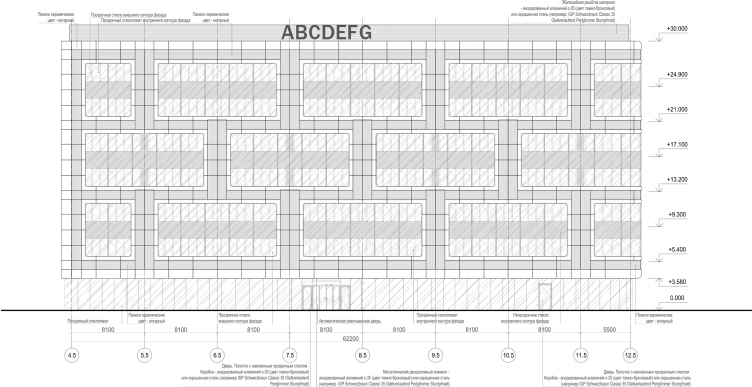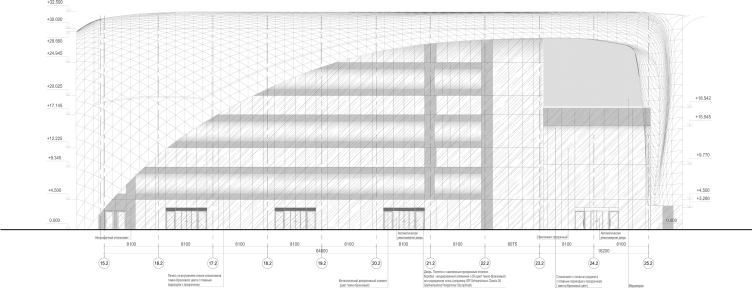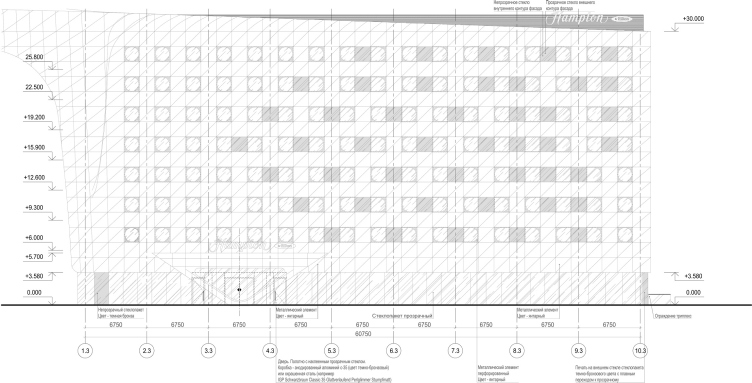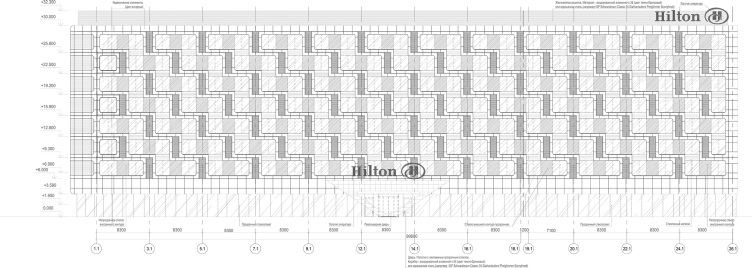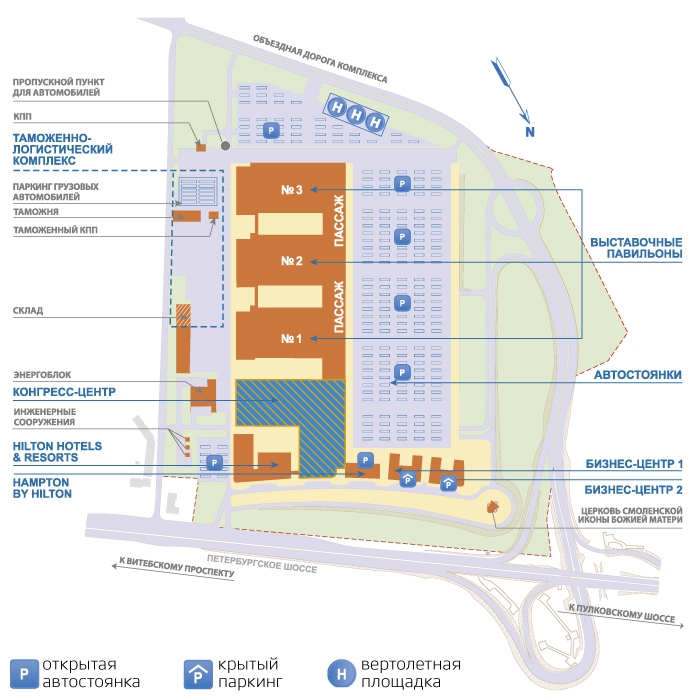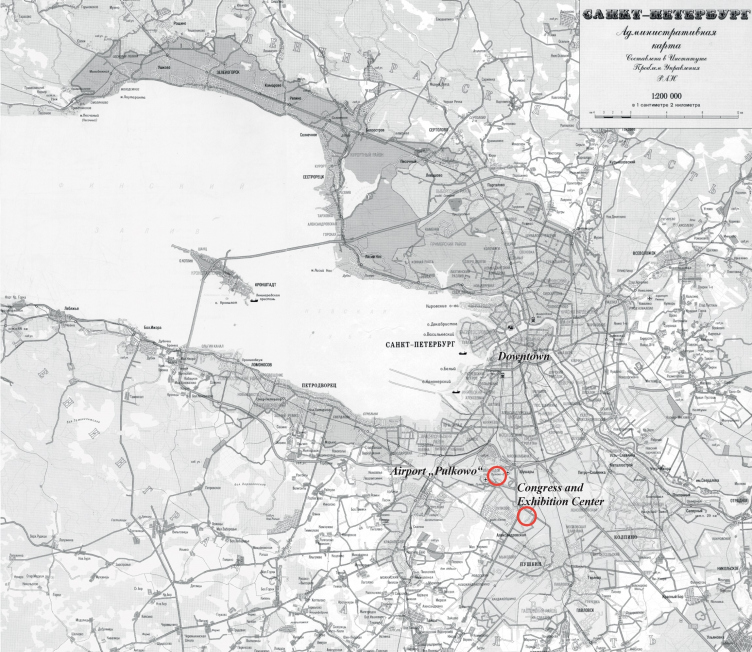Last year, the venue of EXPOFORUM hosted the Saint Petersburg International Economic Forum – a large-scale event, for which, actually, the complex was built, in order to replace the morally and physically outdated LENEXPO. Today’s EXPOFORUM has very little about it of the original project of the complex, with which Evgeny Gerasimov and Sergey Tchoban once won the international competition, and even the final approved version that passed all the expertise was also slightly altered in the course of construction. But then again, it’s only the first stage of construction that has been currently completed.
EXPOFORUM © SPEECH, Evgeny Gerasimov and Partners
EXPOFORUM © SPEECH, Evgeny Gerasimov and Partners
EXPOFORUM © SPEECH, Evgeny Gerasimov and Partners
The place for the center is a lucky one – it is located at the crossing of several large-scale highways, in the immediate proximity to the international airport, and at the Pulkovskie Hills, the rare case of elevation, rare for Saint Petersburg’s terrain. It is understood that good transport accessibility is one of the key assets of any international convention center. Just as important is the comfort of stay, the convenience of inner traffic, intuitive navigation, flexibility and variability of its modules, sturdy technical and material base, and, last but not least, eye-catching design: for thousands of visitors arriving to forums, exhibitions and conventions, these complexes play the role of the city’s or even the nation’s face. So it comes as no surprise that design and construction of such complexes around the world is done by the most prominent architects. It would not be an overstatement to say that the architecture of EXPOFORUM successfully solves all of the tasks mentioned above.
EXPOFORUM. Location plan © SPEECH, Evgeny Gerasimov and Partners
Congress and trade show center EXPOFORUM on the Peterburgskoe Highway. Construction, 2014. Evgeny Gerasimov and Partners, SPEECH, nps tchoban voss. Photograph © D.Chebanenko
Congress and trade show center EXPOFORUM on the Peterburgskoe Highway. Construction, 2014. Evgeny Gerasimov and Partners, SPEECH, nps tchoban voss. Photograph © D.Chebanenko
The face of the complex consists of five buildings that stand in a graceful arc along the Peterburgskoe Highway: two business centers, Hilton and Hampton by Hilton hotels, and a congress center, from which a long passage leads to the expo pavilions. “The location of the complex just outside the city boundary and next to the airport accounted for the necessity of creating bright and recognizable façades that would look great from remote vantage points” – explains one of the authors of the project, leader of the firm SPEECH, Sergey Tchoban. Visually, all the five façades are grouped into one smooth line, although in reality these are independent buildings that also perform different functions. The impression of unity is achieved first of all by the color: all of the façades of the complex are designed in uniform golden tones that bring up the textbook associations with the Amber Room and the “Golden Autumn” – incidentally, the town of Pushkin (named after the famous Russian poet who is believed to be the first to come up with the metaphor) is not far away either. The buildings are decorated with volumetric ceramic panels from extruded ceramics. “All the panels were made specifically for this project, including the unique curvilinear elements, which allowed us to soften the outlines of the buildings” – explains Andrey Perlich, the chief architect of the project (SPEECH).
This line is broken but once by the fully-glass façade of the congress center. According to the project, it is covered by a golden “sail” marquee 30 meters high, which must become the main architectural accept of the entire complex. It was decided not to actually build the marquee for the inauguration of the EXPOFORUM but, according to Evgeny Gerasimov, there is still hope that, as part of the second stage of construction, this element will finally occupy its due place.
Congress and trade show center EXPOFORUM on the Peterburgskoe Highway. Construction, 2014. Evgeny Gerasimov and Partners, SPEECH, nps tchoban voss. Photograph © D.Chebanenko
All the five buildings are of the same height, although both hotels have eight floors in them, while the business centers have seven. Given the unity of form and color, the only way to show the outer individuality of the buildings was to play with the window apertures. For each of the buildings, the architects chose its own rhythm, its own principle, according to which the windows are grouped together or, conversely, get dispersed over the façade. For example, in one of the business centers, they are united in large elongated groups, two stories high, which put one in the mind of the TASS building, while in the other one the vertical and horizontal pairs alternate.
Congress and trade show center EXPOFORUM on the Peterburgskoe Highway. Construction, 2014. Evgeny Gerasimov and Partners, SPEECH, nps tchoban voss. Photograph © D.Chebanenko
EXPOFORUM © SPEECH, Evgeny Gerasimov and Partners
Congress and trade show center EXPOFORUM on the Peterburgskoe Highway. Construction, 2014. Evgeny Gerasimov and Partners, SPEECH, nps tchoban voss. Photograph © D.Chebanenko
Congress and trade show center EXPOFORUM on the Peterburgskoe Highway. Construction, 2014. Evgeny Gerasimov and Partners, SPEECH, nps tchoban voss. Photograph © D.Chebanenko
Congress and trade show center EXPOFORUM on the Peterburgskoe Highway. Construction, 2014. Evgeny Gerasimov and Partners, SPEECH, nps tchoban voss. Photograph © D.Chebanenko
Congress and trade show center EXPOFORUM on the Peterburgskoe Highway. Construction, 2014. Evgeny Gerasimov and Partners, SPEECH, nps tchoban voss. Photograph © D.Chebanenko
Congress and trade show center EXPOFORUM on the Peterburgskoe Highway. Construction, 2014. Evgeny Gerasimov and Partners, SPEECH, nps tchoban voss. Photograph © D.Chebanenko
Congress and trade show center EXPOFORUM on the Peterburgskoe Highway. Construction, 2014. Evgeny Gerasimov and Partners, SPEECH, nps tchoban voss. Photograph © D.Chebanenko
Congress and trade show center EXPOFORUM on the Peterburgskoe Highway. Construction, 2014. Evgeny Gerasimov and Partners, SPEECH, nps tchoban voss. Photograph © D.Chebanenko
Congress and trade show center EXPOFORUM on the Peterburgskoe Highway. Construction, 2014. Evgeny Gerasimov and Partners, SPEECH, nps tchoban voss. Photograph © D.Chebanenko
The façade of the Hampton by Hilton hotel (in the middle) is slit with circular bullseye-style openings, which, as they recede from the congress center, gather into ever-lengthening “snakes”.
Congress and trade show center EXPOFORUM on the Peterburgskoe Highway. Construction, 2014. Evgeny Gerasimov and Partners, SPEECH, nps tchoban voss. Photograph © D.Chebanenko
The regular orthogonal grid of the windows of the Hilton hotel is livened up by golden “little staircases” that dissect the façade from top to bottom.
EXPOFORUM. Interior © SPEECH, Evgeny Gerasimov and Partners
Pending the absence of the “golden sail”, the glass façade of the congress center is livened up by the plastique alone: against the serene glass backdrop billow three smooth horizontal “waves” – at the level of the second, fourth, and sixth floors.
EXPOFORUM. Interior © SPEECH, Evgeny Gerasimov and Partners
EXPOFORUM. Interior © SPEECH, Evgeny Gerasimov and Partners
There is a 500-meter passage stretching into the depth of the complex from the congress center, upon which, as the main “axis”, the three expo pavilions are strung. Andrey Perlich describes this passage – which seemingly performs a purely utilitarian function – as “the most spectacular and sophisticated part of the exhibition complex”. Its façades are up to 16 meters high, these façades being completely made of glass – specially for EXPOFORUM insulated glass units 5.5 meters high were made. To heat such a giant volume, two rows of convectors were required that were installed on the bottom and middle levels. The unique wave-shaped roof with skylights (into which LED’s are installed) saves this grandiose space from looking monotonous, which is the issue characteristic for many such passages in similar complexes around the world.
Congress and trade show center EXPOFORUM on the Peterburgskoe Highway. Construction, 2014. Evgeny Gerasimov and Partners, SPEECH, nps tchoban voss. Photograph © D.Chebanenko
EXPOFORUM © SPEECH, Evgeny Gerasimov and Partners
EXPOFORUM. The first version of the project © SPEECH, Evgeny Gerasimov and Partners
As for the expo pavilions itself, the area of each of which is over 13 000 square meters, here the architects set for themselves and solved a whole number of most challenging technical tasks. Huge tor gates, unsupported 90-meter girder spans, pull-out partitions that divide, if necessary, the halls into sections – everything in this complex is indeed state of the art. The outside façades of the pavilions, designed in the same golden tones, are decorated by the symbols of Saint Petersburg: the most famous historical buildings and monuments, ships, and palaces. The decoration uses the famous drawings by Mikhail Makhaev. The images are photo printed upon the large ceramic plates 3 millimeters thick, the interesting fact being that the printing was made on ceramic granite before heat-treating it in the furnace - a solution unique for Russia that ensures the long lifetime of the plates and images.
EXPOFORUM. Project, 2009 © SPEECH, Evgeny Gerasimov and Partners
EXPOFORUM. Expo pavilion © SPEECH, Evgeny Gerasimov and Partners
Currently, there are three complete pavilions; the construction of another three on the other side of the passage has yet been postponed. If they are indeed built in the long run, the giant parking lot that now occupies all the vacant space will have to go underground.
In the course of construction, on the territory of the complex were discovered the remains of the foundation of the church of the Smolensk Icon of the Mother of God, built in the XVIII century by Giacomo Antonio Domenico Quarenghi and destroyed during the Second World War. The church was completely restored by the old drawings and not it adorns the grand façade of the complex, which overlooks the Peterburgskoe Highway.
Milan, Frankfurt, Cologne, and Kwangchow – it is common knowledge what an important role is played in the life of these cities by international trade shows that take place in them almost all the year round. At the moment, it is hard to say which was primary: was it the necessity for organizing trade shows that determined the construction of expo centers in these cities or is it the other way around - the all-but-unlimited possibilities of Fiera Milano, Messe Frankfurt, KoelnMesse or Pazhou attract the organizers of the world’s largest trade shows. With the advent of EXPOFORUM, Saint Petersburg will also have a right to claim the status of a venue for such grand-scale events. Whether this will come to pass, only time can tell – but the architects have definitely done their job: now the city does have a venue worthy of hosting world-class conventions and trade shows.
EXPOFORUM. Business center © SPEECH, Evgeny Gerasimov and Partners
EXPOFORUM. Business center © SPEECH, Evgeny Gerasimov and Partners
EXPOFORUM. Congress center © SPEECH, Evgeny Gerasimov and Partners
EXPOFORUM. Congress center © SPEECH, Evgeny Gerasimov and Partners
3-star hotel © SPEECH, Evgeny Gerasimov and Partners
4-star hotel © SPEECH, Evgeny Gerasimov and Partners
Section view-1 © SPEECH, Evgeny Gerasimov and Partners
Section view-2 © SPEECH, Evgeny Gerasimov and Partners
Passage © SPEECH, Evgeny Gerasimov and Partners
EXPOFORUM © SPEECH, Evgeny Gerasimov and Partners
Location plan © SPEECH, Evgeny Gerasimov and Partners
Rough masterplan © SPEECH, Evgeny Gerasimov and Partners
